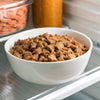Can I Mix Wet and Dry Dog Food? Exploring the Pros, Cons, and Best Practices
- Houndsy
Table of Contents
- Introduction
- The Basics of Dog Food: Understanding Wet and Dry Options
- Why Mix Wet and Dry Dog Food?
- How to Properly Mix Wet and Dry Dog Food
- Potential Downsides of Mixing Wet and Dry Dog Food
- Special Considerations When Mixing Dog Food
- Conclusion
Introduction
Imagine this: you’re watching your beloved furry friend turn their nose up at their dog food, and feeling frustrated as you realize that mealtime has turned into a battle of wills. If you’ve found yourself in this situation, you’re not alone. Many dog owners face the challenge of ensuring their pets are not only well-nourished but also excited about their meals. Recent studies show that up to 60% of dogs are picky eaters, leading to concerns about their nutrition and overall health.
Today, we want to tackle an important question that resonates with many pet parents: Can I mix wet and dry dog food? This blog post dives deep into the considerations, benefits, and best practices associated with this mixing technique. By the end, you will have a clearer understanding of how to elevate your dog's feeding routine and maintain their interest in mealtime, all while ensuring they receive a balanced diet.
Through exploring the components of both wet and dry dog food, understanding the implications of mixing them, and discussing practical tips for implementation, we aim to equip you with knowledge and confidence as a pet owner. So, let’s dig in!
The Basics of Dog Food: Understanding Wet and Dry Options
To appreciate the practice of mixing wet and dry dog food, we first need to understand what each type of food offers.
What is Dry Dog Food?
Dry dog food, commonly known as kibble, is widely favored for its convenience and storage capabilities. It typically contains about 10-12% moisture, allowing it to have a long shelf life even after the package is opened. Here are some distinguishing features:
- Balanced Nutrition: Formulated to meet AAFCO guidelines, dry kibble often provides complete nutrition, including vital vitamins and minerals.
- Dental Health Benefits: The crunchiness of dry kibble promotes better dental health by helping to scrub plaque from your dog’s teeth as they chew. However, the effectiveness varies based on kibble shape and formulation.
- Cost-Effectiveness: Generally more affordable than wet food, dry dog food allows for larger quantity purchases without worrying about spoilage.
What is Wet Dog Food?
On the other hand, wet dog food typically contains 75-78% water, providing hydrating benefits that can be especially appealing for dogs with specific health issues or picky appetites. Here are some features of wet dog food:
- Enhanced Palatability: Its texture and aroma are often irresistible to dogs, making it an excellent option for enticing fussy eaters.
- Easier to Chew: The softer nature of wet food can be an advantage for older dogs or those with dental problems.
- Variety in Flavor: Wet food usually offers a wider range of flavors and textures, making mealtime more enjoyable.
Key Differences at a Glance
| Feature | Dry Dog Food | Wet Dog Food |
|---|---|---|
| Moisture Content | 10-12% | 75-78% |
| Shelf Life | Long-lasting when stored correctly | Needs refrigeration after opening |
| Palatability | Less enticing for picky eaters | High palatability and aroma |
| Cost | Generally more affordable | Typically more expensive per serving |
| Dental Health Benefits | Can aid in dental cleanup | Minimal benefit for dental health |
Why Mix Wet and Dry Dog Food?
Now that we have a clear understanding of both food types, we can explore the reasoning behind mixing them. Below are several compelling benefits to consider:
1. Increased Flavor and Variety
Dogs, like humans, can experience palate fatigue. Introducing wet food into dry kibble can transform an average bowl into a culinary delight, which is especially beneficial for picky eaters. Mixing the two can encourage your dog to finish their meals while enjoying a broader range of flavors and textures.
2. Enhanced Hydration
Adding wet food to a dry diet significantly boosts the moisture content of your dog's meals. This added hydration is especially critical for dogs that may not drink enough water throughout the day, helping prevent urinary tract issues and promoting kidney health.
3. Nutritional Synergy
By combining wet and dry dog food, you create a more balanced meal that incorporates the advantages of both types. While wet food provides appealing flavors and hydration benefits, dry food contributes to dental health and can be easier to measure for consistent portion control.
4. Cost Management
If your dog tends to be a picky eater, feeding them entirely with wet food can become expensive. Mixing allows you to maintain flavor and variety while reducing the overall cost, since you can use less wet food mixed with a more affordable dry kibble.
How to Properly Mix Wet and Dry Dog Food
Mixing wet and dry dog food effectively is essential to ensure your dog receives balanced nutrition while avoiding potential pitfalls. Here are some practical tips for a successful mixing approach:
1. Determine the Right Ratio
A commonly recommended starting point is to use a ratio of 75% dry food to 25% wet food. This can be adjusted based on your dog’s needs, age, weight, activity level, and health concerns. For example:
- For picky eaters or senior dogs, consider increasing the wet food portion to 50% if they need additional enticement.
- If you have a weight control issue, consult with your veterinarian to find the best proportion that satisfies hunger without excess calorie intake.
2. Gradual Transition
When introducing a new mixture to your dog’s diet, transition gradually to avoid any digestive upset. Begin with a small amount of wet food mixed in their regular dry food and slowly increase the proportion over a week.
3. Monitor Their Response
Pay attention to how your dog reacts to the mixed meal. Are they excited about mealtime? Monitor for any signs of digestive distress, such as vomiting or diarrhea, and adjust the ratio as needed.
4. Proper Food Storage
To maintain freshness and prevent spoilage, store dry food in a cool and dry place using an airtight container. For wet food, always refrigerate any uneaten portions and use them within a few days to avoid bacteria growth.
5. Keep a Clean Feeding Area
After feeding, remove any uneaten food within 30 minutes, particularly for mixtures, as soggy kibble can lose its appeal and spoil quickly. This practice ensures your dog always has fresh meals and prevents any unwanted pests.
Potential Downsides of Mixing Wet and Dry Dog Food
While mixing wet and dry dog food boasts various benefits, it is essential to consider potential drawbacks:
1. Increased Cost
Although mixing can be more economical than feeding solely wet food, it still adds up since wet food is generally pricier than dry kibble. Establish a budget for your dog's food and consult your veterinarian for quality yet budget-friendly options.
2. Risk of Spoilage
Wet food must be consumed within a few days after opening. If your dog doesn’t finish their meal promptly, it could lead to waste, spoilage, and even bacterial growth that could harm your pet’s health.
3. Compromised Dental Health
Wet food typically does not provide the same dental benefits as dry kibble. If your dog relies heavily on wet food, consider including dental chews or implementing a regular dental cleaning routine with your veterinarian.
Special Considerations When Mixing Dog Food
When contemplating whether to mix wet and dry dog food, there are specific factors to consider based on your dog's individual health needs:
1. Health Conditions
If your dog has any underlying health issues—such as obesity, diabetes, or urinary problems—consult your veterinarian first. Certain health conditions might require tailored diets, and there’s a possibility that mixing could dilute therapeutic formulas.
2. Aging Dogs
Senior dogs often face challenges with their teeth and senses. Mixing wet and dry food can greatly enhance their dining experience. However, if you notice any dental discomfort, increasing the ratio of wet food may be necessary.
3. Puppies and Transitional Diets
Puppies can also benefit from a mixed diet once they are weaned. Introduce them to a combination of wet and dry food gradually, considering their nutritional needs based on their growth stage.
Conclusion
Mixing wet and dry dog food can undoubtedly transform your pet's mealtime from mundane to delightful while catering to their nutritional requirements. The benefits, from enhanced taste and hydration to cost management and dental health, are numerous—making this practice an excellent option for many dog owners.
As we’ve explored throughout this blog post, there are specific considerations and best practices that can help you introduce and maintain a mixed feeding strategy successfully. By paying attention to your dog’s needs and gradually transitioning to a balanced mix, you can ensure that mealtime becomes a rewarding experience for both you and your furry friend.
Ready to elevate your dog’s feeding experience? Consider exploring the Houndsy Kibble Dispenser, which simplifies portion control and maintains a fresh food environment for your beloved pet! Check it out here: Houndsy Kibble Dispenser.
FAQ
Q1: Can I mix any types of wet and dry food together?
It is best to combine products that are complete and balanced for your dog's specific life stage. Always consult your veterinarian when making significant changes to your dog's diet.
Q2: What if my dog does not like the mixture?
If your dog shows reluctance to eat the mixed food, try altering the proportions slowly or consider introducing different flavors or brands of both wet and dry food.
Q3: How do I ensure my dog receives adequate nutrition while mixing?
Consult your veterinarian to determine appropriate serving sizes and combinations. Monitoring your dog’s health and body condition score can also help ensure nutritional adequacy.
Q4: Can mixing foods cause digestive issues?
While mixing wet and dry food is generally safe, some dogs may experience digestive upsets. Introduce mixed meals gradually and keep an eye on your dog’s response.
Embark on this journey with knowledge and love, and watch your pet thrive through a happy and balanced mealtime experience!












